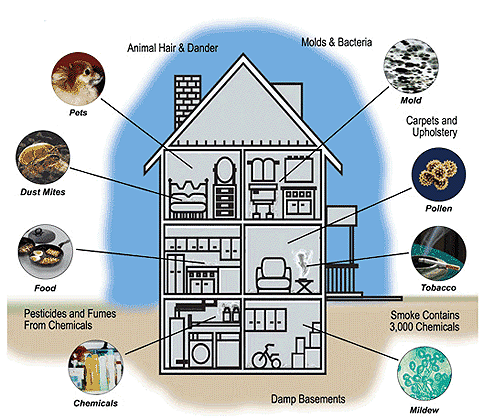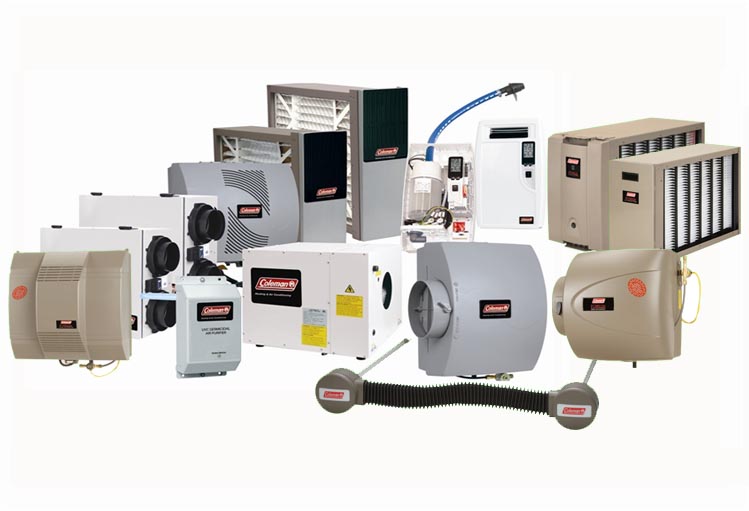
Indoor Air Quality
What Should You Know?
According to the Environmental Protection Agency (EPA), indoor air is anywhere from 2 to 10 times more hazardous than outdoor air. In fact, the EPA warns that the indoor air quality is the United States' number one environmental health problem. As a result of the toxic air we breathe, EPA studies have shown that billions of dollars are spent annually for medication to help Americans breathe or cure their respiratory illnesses.
Information given at the First Annual Air Quality convention sponsored by EPA on April 1992, included these facts:
- Eleven million Americans have asthma.
- Twenty-eight million have hay fever and other allergies.
- 20% of all employees have a major illness related to indoor air pollution such as allergies, asthma, autoimmune diseases, etc.
- EPA estimates an 18% annual production loss to American business due to poor indoor air quality.
- 40% of all buildings pose a serious health hazard due to indoor air pollution, according to the World Health Organization.
- Scientists now recognize that pollutants, even at acceptable concentration, combined together in an indoor environment have a synergistic negative effect.
Every year at least 6,000 new chemical compounds are developed. Many are used indoors every day, at home and at work. Add to these pollutants the mold, mildew, bacteria, viruses, tobacco smoke, grease, pollen, dirt, asbestos, lead, and numerous other contaminants that can affect our breathing and our health. Then allow them to circulate in today's nearly airtight indoor environment. No wonder our indoor air is, on average, two to ten times as polluted as the worst outdoor air.
Viruses and bacteria that thrive in the ducts, coils, and recesses of building ventilation systems have been proven to cause ailments ranging from influenza to tuberculosis. Some HVAC systems have been found to contain up to 27 species of fungi.
Should you be concerned about Indoor Air Quality?
Here are 5 reasons why indoor air quality could be making your sick:
- It is now widely recognized that most people spend more than 90% of their time indoors. Because most of us spend so much time inside, indoor pollution concentrations, even if they are uniformly lower than outdoor levels, make a significant contribution to our average exposure over a day, week, month, or year.
- Modern indoor environments contain a complex array of potential sources of air pollution, including synthetic building materials, consumer products, and dust mites. Airborne emissions also occur because of the people, pets, and plants that inhabit these spaces. Efforts to lower energy costs by reducing ventilation rates have increased the likelihood that pollutants generated indoors will accumulate.
- Monitoring studies inside buildings and vehicles have consistently found that concentrations of many air pollutants tend to be higher indoors than out. Indoor air has been shown to be a complex mixture of chemical, biological, and physical agents.
- Complaints about inadequate indoor air quality and associated discomfort and illness are a burgeoning problem in our society. Reports of illness outbreaks among building occupants, particularly office workers, with no secondary spread of illness to others outside the building with whom affected individuals come into contact have become commonplace. EPA classifies these reports into two general categories: building related illnesses and sick-building syndrome.
- Exposures to many indoor air pollutants are known or suspected to occur at levels sufficient to cause illness or injury. Scientific evidence suggests that respiratory disease, allergy, mucous membrane irritation, nervous system effects, cardiovascular effects, reproductive effects, and lung cancer may be linked to exposures to indoor air pollutants.
Scientists consistently rank indoor air pollution at or near the top of environmental health risks in the United States.
For more info please read the Consumer Product Safety Commission's Document #450 "The Inside Story: A Guide to Indoor Air Quality":
http://www.cpsc.gov/cpscpub/pubs/450.html
What Is the Solution?
Top Three Basic Strategies
Source Control
Usually the most effective way to improve indoor air quality is to eliminate individual sources of pollution or to reduce their emissions. Some sources, like those that contain asbestos, can be sealed or enclosed; others, like gas stoves, can be adjusted to decrease the amount of emissions. In many cases, source control is also a more cost-efficient approach to protecting indoor air quality than increasing ventilation because increasing ventilation can increase energy costs. Specific sources of indoor air pollution in your home are listed later in this section.
Ventilation Improvements
Another approach to lowering the concentrations of indoor air pollutants in your home is to increase the amount of outdoor air coming indoors. Most home heating and cooling systems, including forced air heating systems, do not mechanically bring fresh air into the house. Opening windows and doors, operating window or attic fans, when the weather permits, or running a window air conditioner with the vent control open increases the outdoor ventilation rate. Local bathroom or kitchen fans that exhaust outdoors remove contaminants directly from the room where the fan is located and also increase the outdoor air ventilation rate.
It is particularly important to take as many of these steps as possible while you are involved in short-term activities that can generate high levels of pollutants--for example, painting, paint stripping, heating with kerosene heaters, cooking, or engaging in maintenance and hobby activities such as welding, soldering, or sanding. You might also choose to do some of these activities outdoors, if you can and if weather permits.
Advanced designs of new homes are starting to feature mechanical systems that bring outdoor air into the home. Some of these designs include energy-efficient heat recovery ventilators (also known as ERV's or HRV's).
Air Cleaners
There are many types and sizes of air cleaners on the market, ranging from relatively inexpensive table-top models to sophisticated and expensive whole-house systems. Some air cleaners are highly effective at particle removal, while others, including most table-top models, are much less so. Air cleaners are generally not designed to remove gaseous pollutants.
The effectiveness of an air cleaner depends on how well it collects pollutants from indoor air (expressed as a percentage efficiency rate) and how much air it draws through the cleaning or filtering element (expressed in cubic feet per minute). A very efficient collector with a low air-circulation rate will not be effective, nor will a cleaner with a high air-circulation rate but a less efficient collector. The long-term performance of any air cleaner depends on maintaining it according to the manufacturer's directions.
Another important factor in determining the effectiveness of an air cleaner is the strength of the pollutant source. Table-top air cleaners, in particular, may not remove satisfactory amounts of pollutants from strong nearby sources. People with a sensitivity to particular sources may find that air cleaners are helpful only in conjunction with concerted efforts to remove the source.
Over the past few years, there has been some publicity suggesting that houseplants have been shown to reduce levels of some chemicals in laboratory experiments. There is currently no evidence, however, that a reasonable number of houseplants remove significant quantities of pollutants in homes and offices. Indoor houseplants should not be over-watered because overly damp soil may promote the growth of microorganisms which can affect allergic individuals.
At present, EPA does not recommend using air cleaners to reduce levels of radon and its decay products. The effectiveness of these devices is uncertain because they only partially remove the radon decay products and do not diminish the amount of radon entering the home. EPA plans to do additional research on whether air cleaners are, or could become, a reliable means of reducing the health risk from radon.
Other Very Effective Methods
UV (Ultraviolet) Treatment Systems
With “tighter,” more energy efficient homes – the quality of indoor air has declined dramatically. The air circulating in the ductwork of the average home or office can be concentrated with contaminants including molds, bacteria, and viruses. Basic filtering systems offer little help because these airborne contaminants either pass through a filter or collect on filter medium and grow. Ultraviolet light can help fill the indoor air quality gap and clean the contaminants in the air that filters can’t.
The germicidal effects of UV light cause photochemical damage to DNA and RNA within microorganisms. UV technology is widely used in hospitals, pharmacies, and commercial kitchens to kill airborne and surface microorganisms like mold and bacteria. Now homeowners can benefit from UV products, too.
The air in a home will pass through the HVAC system up to 75 times per day during the heating/cooling season and up to 150 time per day if the system is in continuous fan mode.
Ultraviolet lamps can be easily added to an existing forced air system. Lamps can be installed either in the main supply or return duct of a central heating or air syste . Condensation on air conditioning coils and standing water in the drip pan below provide a breeding ground for bacteria and mold. A properly placed UV lamp above the coil can eliminate these risks and can clean the air as it passes into the supply ductwork of the home. UV lamp systems can also be placed in the return air ductwork to clean the air as it passes through the system.
Humidity Control:
Humidification-
Helps relieve physical symptoms such as dry nose, cracked, itchy skin, and sore throats. As well as allergy and asthma symptoms and painful static shocks. Home humidification systems also help with the non-physical symptons like chipping paint and plaster, splitting or cracked wood floors, furniture, trim and molding.
Turning your temperature up in the wintertime will keep you warm but won’t increase your home’s humidity level. Daily activities such as showering, cooking and doing laundry doesn't produce enough moisture to keep your home’s air from being too dry.
A Whole-Home Humidifier installed by your heating and cooling professional, will deliver the perfect amount of moisture to your air making you feel more comfortable at lower thermostat settings. In fact, the EPA states that you can save up to 4% on your heating bill for every degree you lower your thermostat! Increase your family’s level of comfort and protect your valuable furnishings by adding just the right amount of moisture with a Whole-House Humidifier!
“If too dry an environment is your problem, consider a humidifier. Clues like awakening with a sore throat, dryness in your nose, dry skin, static electricity or dry, itchy eyes are all signs of too little humidity.”
Dehumidification-
High levels of humidity can make your home feel sticky and potentially create a breeding ground for mold, mildew, dust mites and bacteria.
As homes become more energy-efficient and more tightly sealed, moisture becomes trapped inside the home. Dehumidification can help balance indoor humidity levels, minimize the potential for mold and other pollutants and create a healthier indoor environment for your family.
